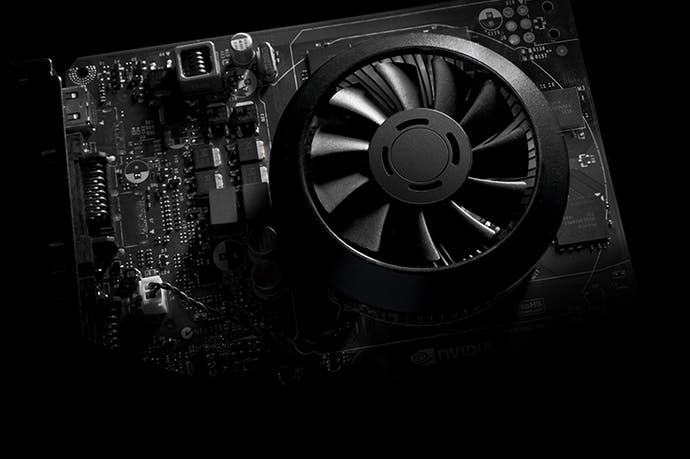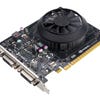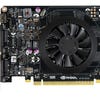Nvidia GeForce GTX 750 Ti review
The new Maxwell architecture debuts in an ultra-efficient entry-level GPU.
Now this is something different. It's the usual form for graphics cards vendors to unleash a brand new architecture with their latest and greatest high-end products. Yet here we are, with Nvidia's eagerly awaited new "Maxwell" technology receiving its debut in the form of a mainstream gaming product - the £115 GeForce GTX 750 Ti. What the new card may lack in raw gaming power, it more than makes up for in terms of efficiency and sheer innovation - in many ways, it's a stunning little piece of technology.
So what does Maxwell bring to the table? Remarkably, Nvidia claims to have doubled performance per watt compared to its previous Kepler technology, thanks to a combination of factors where a new CUDA core configuration and a massive boost in L2 memory cache (2MB vs. 256K) appear to provide the most tangible benefits. The big news here is that Nvidia has achieved this without moving to a new fabrication node - just like Kepler, Maxwell is a 28nm chip. It's usually the case that new GPU technologies are rolled out alongside new manufacturing technologies, but the new 20nm process still isn't ready for show-time. Indeed, Nvidia has indicated to us that we won't see any 20nm cards this year, but that's OK - Maxwell isn't just about improved performance per watt, it's about getting more processing power from a smaller area of die-space too.
You don't quite realise just how much of an achievement Maxwell actually is until you first hold GTX 750 Ti in your hands. The GM107 chip on the new card is tiny, with a relatively minuscule heatsink and fan, oddly reminiscent of the stock coolers supplied in the box with Intel CPUs. The board itself is very, very small - about the size of an old Soundblaster audio card, and it requires no additional PCI Express power cables from the power supply, making it an ideal upgrade for cheaper PCs lacking the necessary PSU connections for enthusiast gaming.
All of this sounds interesting, but probably not that exciting if the GTX 750 Ti delivers only mediocre gaming performance. Thankfully, that is not the case: the GTX 750 Ti handily outperforms its nearest competitor - the Radeon R7 260X - and it does so with a 60W TDP, as opposed to the 115W TDP on the AMD product. Lest we forget, we recently compared the 260X to next-gen console across a range of multi-platform games and found the AMD experience to either match or exceed what Xbox One or PS4 were capable of, with the exception of the poorly optimised computer edition of Call of Duty: Ghosts. The GTX 750 Ti performs likewise, if not a touch better.
It's a remarkable little package for sure, though the surrounding technology is very much of the standard form found in the £100 GPU area. Similar to the GTX 650, external interfaces are limited - we have two dual-link DVI connections in addition to a mini-HDMI interface (requiring an adaptor or new cable). However, the biggest challenge the card faces is more technical in nature - specifically, a constrictive 128-bit memory bus hooking up the main GM107 chip to its 2GB of onboard GDDR5. Games love big, fat, wide interfaces to graphics RAM, and narrower buses can cause issues with bandwidth-intensive tasks like multi-sampling anti-aliasing (MSAA).
So what kind of performance can this hardware achieve? Our first test is a trip to the Baku warzone of Battlefield 4, with 1080p resolution engaged and high settings enabled across the board. This offers up a beautiful-looking slice of entertainment, but without the excesses of DICE's ultra presets - in particular the deferred multi-sampling anti-aliasing that brutally hammers the memory bandwidth that the entry-level enthusiast GPUs simply don't have. Just like the R7 260X it competes with, full 1080p at a sustained 60fps is off the table but by moving to 1600x900 - the PS4 resolution setting - we get a silky smooth arcade-style experience. Not bad for a bus-powered, relatively inexpensive graphics card.
Direct comparisons with the 260X also reveal a performance advantage on a game specifically optimised in association with AMD, ranging from anything between 4fps to 10fps in like-for-like scenes. However, in terms of the actual feel of the game, the difference is fairly minimal across the run of play. That said, if you're looking for a locked 60fps with v-sync enabled - the console experience, if you like - any additional horsepower is welcome to stop you dropping beneath that magical target frame-rate, and there are a few instances of that occurring in the video below.
"Similar to the R7 260X, the GTX 750 Ti offers up enough raw rendering power to match or exceed next-gen console performance in Battlefield 4, moving ahead of its AMD rival just a touch."
Alternative analysis:
So with the DICE epic addressed, it's time to push the new Maxwell technology still further. Many consider Crysis 3 performance to be the true barometer of a graphics card's mettle, and perhaps not surprisingly, here we find that overall feel of the game remains very similar to the R7 260X. At 1080p we ran the game at high settings, with 2x SMAA anti-aliasing and very high texture quality and enjoyed a decent experience with frame-rates north of 30fps. Dropping down to medium quality boosts performance as you would expect, but at the expense of a less consistent experience. Similar to the R7 260X, our recommendation here would be to play the game on the more demanding settings, and either leave frame-rate as it is, or else utilise a tool like MSI Afterburner to cap performance at 30fps to eliminate judder.
Again, we find that the GTX 750 Ti generally enjoys a boost over the R7 260X in like-for-like testing - generally in the area of 4fps - but having played the Welcome to the Jungle stage back-to-back with both cards, gameplay felt like much of a muchness. 60fps is a pipe dream here and with frame-rates during gameplay mostly occupying the 30-40fps area, it's difficult to see the GeForce advantage turn into a palpably better experience.
At this point we decided to measure our system's power draw - and it's here that the GTX 750 Ti's advantage is really felt. On the scripted sequence at the end of Welcome to the Jungle (2:55 in the video), we see a range of graphics and physics at work - a brutal workout for both CPU and GPU. Turning v-sync off to run the game simulation as fast as the system can handle it, we saw a max power spike of 148W, but with an average of around 135W. This is quite remarkable - we're running a Core i7-3770K overclocked to 4.3GHz in addition to the GTX 750 Ti, and we're seeing power consumption in line with PlayStation 4.
"GTX 750 Ti hands in a decent showing on Crysis 3 at 1080p/high but achieving it with system load comparable to PS4 is a stunning achievement, especially when we are running an overclocked Core i7-3770K at 4.3GHz."
Alternative analysis:
Looking to get a better view of what the new GPU is capable of when unleashed on a range of game engines, we move on to our usual benchmark suite. Here we find that the card does indeed beat the R7 260X in all tests - with just Hitman: Absolution presenting a close challenge. We all see some interesting comparisons with what we would perceive to be better specced cards - the Radeon HD 7850 1GB and the GTX 650 Ti Boost. None of these benchmarks trouble the 7850's 1GB RAM limit here, so despite the increased memory bandwidth, we see some curious results - especially on BioShock Infinite.
It's worth pointing out here that we are applying some level of realism to the settings in these particular benches. Ramping up quality to the absolute maximum and applying enormous levels of MSAA is a recipe for failure on entry-level enthusiast cards, and doesn't demonstrate how the technology will actually be used during gameplay. Our strategy here is to reduce multi-sampling to the minimum, and take overall settings down one notch from the "ultra" level. This combination is enough to get us a far more playable experience, but it may cancel out some of the inherent advantages the HD 7850 and GTX 650 Ti Boost could offer.
What's clear from our testing is that Maxwell has so much more to offer - the technology is barely breaking sweat here. Now, we don't usually explore graphics card overclocking that much, but the sheer efficiency of the GTX 750 Ti suggests that Maxwell has quite a lot more under the bonnet than the results here indicate. Maxwell retains Nvidia's own auto-overclocking GPU Boost tech, which in our tests took core speeds up to 1085MHz. Additional overclocking with MSI Afterburner increased that by 135MHz, while we achieved rock solid stability upping memory speed from 2700MHz to 3300MHz.
"Overall performance as indicated by gaming benchmarks suggests a product that can provide both performance and eye candy with miserly power consumption."
| 1920x1080 'Value' | GTX 750 Ti 2GB | R7 260X 2GB | 7850 1GB | GTX 650 Ti Boost 2GB | GTX 750 Ti 2GB (OC) |
|---|---|---|---|---|---|
| BioShock Infinite, Very High | 65.9fps | 57.3fps | 66.9fps | 64.1fps | 74.8fps |
| Tomb Raider, High, FXAA | 66.6fps | 61.1fps | 77.8fps | 78.2fps | 76.9fps |
| Metro 2033, High, AAA | 32.3fps | 29.5fps | 40.0fps | 36.9fps | 36.8fps |
| Metro: Last Light, High | 38.0fps | 34.0fps | 38.6fps | 36.8fps | 43.8fps |
| Hitman: Absolution, High, 2x MSAA | 36.2fps | 36.9fps | 45.0fps | 39.8fps | 41.4fps |
| Sleeping Dogs, Extreme | 51.1fps | 47.9fps | 54.5fps | 54.0fps | 57.4fps |
This added around 15 per cent of additional performance across our range of benchmarks, propelling the GTX 750 Ti from an R7 260X beater to a serious challenger to the Radeon HD 7850. It should be noted though that most of the speed increase came from the memory boost - clearly the 128-bit bus to the GDDR5 is more of a limiting factor on the GTX 750 Ti's performance than the core clock. Enthusiast overclockers may be able to get more - much more - out of this card, but we suspect that the core may be limited by the motherboard-only power supply. Perhaps this will be resolved by third party cards with PCIe connections and more meaty cooling.
In short, the GTX 750 Ti punches above its weight in its sector and with overclocking in place it moves into contention against the Radeon HD 7850 and Nvidia's own GTX 650 Ti Boost, as long as you're reasonable with multi-sampling anti-aliasing (MSAA) and other elements that benefit most from those cards' higher memory bandwidth interfaces. In this video, we re-ran our benchmark tests comparing stock vs. overclock, and we also added frame-time metrics, giving an "in the second" viewpoint on how evenly the card refreshes the image.
So what we're seeing here is a useful boost that's nice to have, and one that propels the GTX 750 Ti up a rung in the GPU comparison ladder, but it should be put into perspective of the all-important gameplay experience. Going back to our Crysis 3 and Battlefield 4 tests, the cumulative increase isn't enough to rule out purchasing a more powerful GPU - and there are many options for significantly more capable kit that aren't that much more expensive.
"Even with just a short test period, we were able to overclock the GTX 750 Ti to deliver 15 per cent more performance across a range of test titles - a useful boost."
Nvidia GeForce GTX 750 Ti - the Digital Foundry verdict
Are we allowed to get this excited about power efficiency? Taken at face value, the GTX 750 Ti won't rock your world in terms of the gameplay experience it delivers, despite favourable comparisons with the next-gen consoles. It's a bit better than the R7 260X - so good enough to run most games at 1080p/high, but it probably won't be troubling the likes of the R9 270X and the GTX 760. However, the arrival of Maxwell has certainly set the cat amongst the pigeons at AMD - the Radeon HD 7850 has been clock-bumped and rebranded as the R7 265, and we should expect price movements as the new Nvidia tech hits the market. However, for all of its technical accomplishment, it's worth pointing out that AMD's R9 270 (the non-X version) is preposterously good value at £130, offering much more raw gaming performance and the wide 256-bit memory bus that so many titles benefit from. In fact it's so good that it makes the £150 270X seem rather over-priced, especially if you're not too concerned about overclocking.
However, the new Nvidia offering is special and unique in its own right, moving into territories where AMD has no answer to its enviable combination of performance and power efficiency. The fact that it's entirely bus-powered with no additional PSU power required opens up the GTX 750 Ti to a vast market of PCs that are otherwise completely unequipped for enthusiast-level gaming. Nvidia is touting the card as ideal for small form factor PCs, where the GTX 750 Ti's miniscule PCB and cool running are likely to make it a very good fit. Indeed, the fact that we could run Crysis 3 at 1080p on high settings with an overclocked i7 and still see power consumption that's competitive with next-gen console is a stunning achievement.
The power efficiency of the technology also bodes well for Nvidia as it releases new cards that scale up into the higher-end levels of the stack. Maxwell also stands to revolutionise gaming laptop performance too: the GTX 750 Ti easily outpaces the GTX 765M found in the Razer Blade 14, and it does so with much the same level of power consumption. And then finally there's the application of the new technology in the successor to the mobile Tegra K1. Maxwell is an architecture designed with mobile in mind first and foremost, and just happens to scale up nicely into powerful, but efficient desktop GPU technology.
In the here and now, the GTX 750 Ti doesn't offer any revelatory increase in gaming performance, but it provides entry-level enthusiast quality in a package quite unlike any other with a ridiculously small power envelope. And if Nvidia is beating AMD's 115W card at just 60W, what's going to happen once the firm starts to release successors to the GTX 760, 770, 780 and Titan? We're not quite sure, but can't wait to find out.








